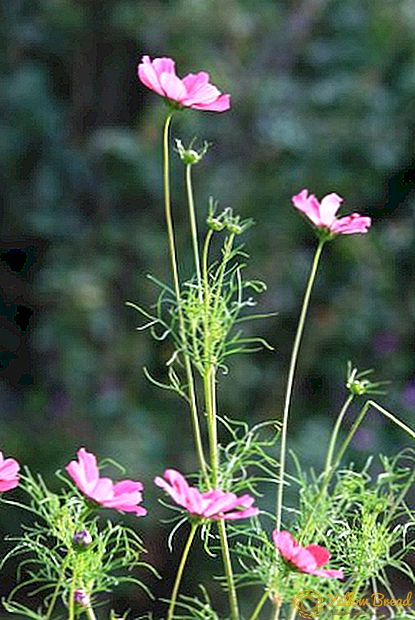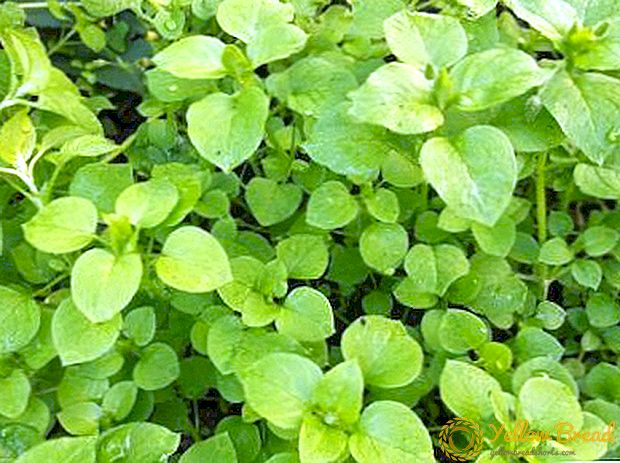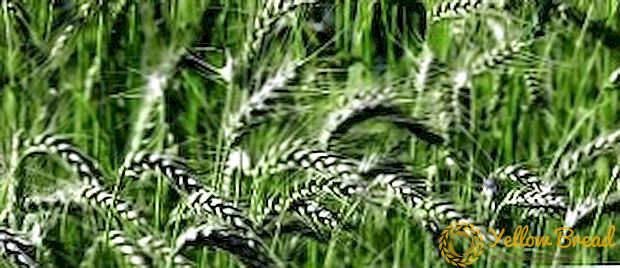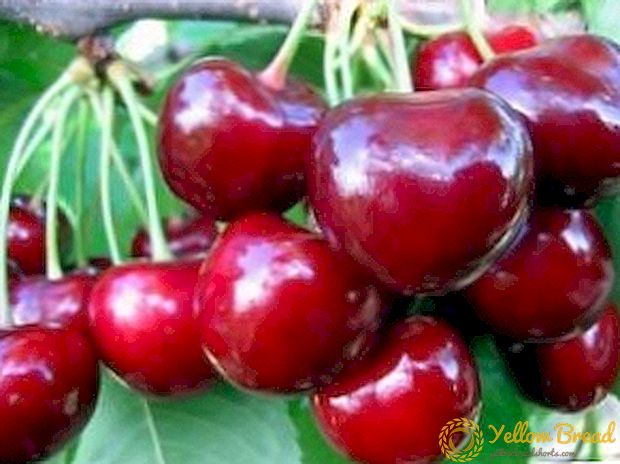 Kosmeya - an amazing plant, its bright and rich flowers are associated with rainbow summer and warm sun.
Kosmeya - an amazing plant, its bright and rich flowers are associated with rainbow summer and warm sun.
Today, this unpretentious plant from Mexico can be found almost everywhere - in urban courtyards and on the lawns of private houses.
Flowerbed with cosmey more like a motley and fluffy green carpet, decorated with multi-colored flowers, asterisks.
Kosmeya is a herbaceous plant belonging to the Aster family. Today there are more than twenty species of this plant.. What is a kosmey and its cultivation is described in detail in this article.
- Growing seed cosme
- Planting cosme seeds for seedlings
- Planting cosmey directly in open ground
- The choice of location and soil for space
- Planting seedlings on the site
- The combination of kosmey with other plants
- Some Cosmeal Care Tips
- When to collect and how to store cosme seeds
- How to prepare perennial space for winter
- Resistance of cosme to pests and diseases
- Types of Cosmee
- Cosmea bipinnatus
- Cosmeus blood red (Cosmos atrosanguineus)
- Cosmeye sulphureus (Cosmos sulphureus)
Growing seed cosme
 The seeds of cosmee species such as sulfur-yellow and twice-penist, are able to maintain good germination for 2-3 years.
The seeds of cosmee species such as sulfur-yellow and twice-penist, are able to maintain good germination for 2-3 years.
Seed method includes two options for planting: nesting and solid. The first method involves the creation of small grooves at a distance of 30-35 centimeters from each other. 3-4 seeds of a plant are placed in each well, and then all this is carefully sprinkled with earth.
In the second method, the seeds are simply spread over the entire surface of the flower bed, pressing it down a little with their palm and sprinkling it with a small layer of humus or fertile soil.
Planting cosme seeds for seedlings
Growing cosme begins with harvesting seedlings. Before planting a seedling for seedlings, it is worth starting with the definition of the planting month. The ideal period is This is March-April. Seeds of cosmea are very light-sensitive, therefore, when sown in seedlings, they need to be slightly pressed into the ground, but not sprinkled.After that, moisten the soil and cover with a transparent film.
 Box of seeds must be put on the light. After 1-2 weeks from the date of sowing the seeds give the first shoots. Optimum temperature for seed germination ranges from +18 to +20 ° C. For the subsequent growth of seedlings need to maintain temperature range from +16 to +18 ° С.
Box of seeds must be put on the light. After 1-2 weeks from the date of sowing the seeds give the first shoots. Optimum temperature for seed germination ranges from +18 to +20 ° C. For the subsequent growth of seedlings need to maintain temperature range from +16 to +18 ° С.
If the shoots are very thick, then they need to be thinned in such a way that the distance between the seedlings was about 10-15 centimeters.
Planting cosmey directly in open ground
Kosmey flowerbed will look great if you follow the rules of planting seeds in open ground.
Planting cosme seeds in open ground is carried out in early spring, after the snow finally melts. Seeds need to be scattered on the surface of the soil in small groups of 3-4 pieces, about every 30-40 centimeters, and lightly tamped with their palm.The embedding depth should be no more than one centimeter.
 With seedless sowing, the cosmela blooms in July and early August. Also sow kosmeyu in open ground can be in late autumn. Kosmeya reproduces beautifully by self-sowing in the autumn period, you will only have to thin out the spring growth that has thickened.
With seedless sowing, the cosmela blooms in July and early August. Also sow kosmeyu in open ground can be in late autumn. Kosmeya reproduces beautifully by self-sowing in the autumn period, you will only have to thin out the spring growth that has thickened.
The choice of location and soil for space
With regard to the cosmey, open and sunny areas, well protected from the wind, are best suited for outdoor care. Kosmeya is very undemanding to the soil. Ideal for it would be loose, drained soil, with an ample supply of organic and mineral fertilizers. The main thing - do not overdo it and use fertilizer in moderation.
Growing kosmey in the shade or partial shade, as well as on overly organic-rich soils can lead to abundant leaf development.
The finally established warm air temperature and a sufficiently heated earth is the best time when it is worth sowing cosmey in open ground.Observe these conditions, and the plant will certainly please you with abundant and bright flowering.
Planting seedlings on the site
 Around mid-May - early June, when it finally becomes warm, it is possible to plant a seedling of a flower.
Around mid-May - early June, when it finally becomes warm, it is possible to plant a seedling of a flower.
Prepare shallow wells measuring 30 x 30 or 35 x 35 centimeters and carefully water them.
After that, proceed to the careful planting of seedlings in these wells, compact the soil and then water it again.
Remember that tall varieties of cosmea need support, so dig in the ground in advance rods or slats to which you can bind an adult shrub. After the kosmeya reaches 50 centimeters in height, pinch the tops of the shoots, and the plant will bush much better.
With the seedling planting method, the cosmela blooms between the months of June and mid-July (this directly depends on the weather conditions and the quality of the seedlings).
The combination of kosmey with other plants
The richness of bright shades of cosmela allows you to make your flowerbed simply stunning Kosmeya in the design of the garden looks very bright on almost any site. A remarkable combination creates a neighborhood of cosme with plants such as phlox, chamomile and marigold.

Tall varieties of kosmey, planted along fences and fences, allow you to create a kind of floral curb. Stunted representatives will look great against the background of higher plants in the flower arrangement of your flower bed.
Some Cosmeal Care Tips
Cosmey care is not burdensome even for novice florists. Here are some tips for cosme care:
- water cosme no more than once a week;
- watering should be abundant; 4-5 buckets of water should be poured under each bush;
- after watering the soil need to loosen, and then remove the weeds;
- use fertilizer for flowering plants to feed the cosmea;
- top dressing is carried out 3 times per season (before budding, during it, and also at the beginning of flowering);
- for more abundant flowering plants can be foliar dressing. To do this, spray the leaves with the preparation "Bud";
- Spending fertilizer cosme, remember the main thing - moderation is needed in everything;
- do not forget to remove the fading flowers of the plant in time;
- if the kosmey has grown quite strongly, then it can be mowed. The advantages of this manipulation are that flowering does not stop, and the bushes of the plants become more compact and attractive.
When to collect and how to store cosme seeds
 For the collection of seeds, it is advisable to choose a clear and dry day. It is usually collected in the afternoon when the morning dew dries out completely.
For the collection of seeds, it is advisable to choose a clear and dry day. It is usually collected in the afternoon when the morning dew dries out completely.
It is best to collect the seeds in small bags of cloth or paper bags.
If there are not too many seeds, then they can be stored in these same bags, arranged as freely as possible in a box. Then this box must be placed in a dry and warm room.
In order not to get confused, write on the bag plant variety and date of collection of seeds. If there are a lot of seeds, they can be scattered into boxes in a thin layer or neatly folded on a sheet of paper. It is best to lay such paper somewhere in the attic or in the shed - the main thing is that it is dry and warm there.
How to prepare perennial space for winter
In order for a perennial cosme to please with abundant flowering next summer, it must be properly prepared for the winter period. As a rule, all flowering perennials hibernating in the ground, you need to cut short, leaving only small hemp height of about 2 centimeters.After pruning the land around the plant, it is necessary to break through, and then pour humus or compost. The layer of mulch should be not less than 5 centimeters.
Resistance of cosme to pests and diseases
 Not many plants can boast of their resistance to pests and diseases. But kosmey is a plant which practically is not afraid of pests.
Not many plants can boast of their resistance to pests and diseases. But kosmey is a plant which practically is not afraid of pests.
The only pests that attack spacecraft are snails and slugs.
You can get rid of them with the help of manual collection. If this method does not bring effect, then you should resort to the treatment of plants with insecticides.
The full range of these drugs is presented in almost any flower shop. The most effective pest control chemicals are Thunderstorm, Lepidotsid, Pochin.
Remember that a one-time processing will not be able to bring a positive result. Cosmea must be processed at least three times at intervals of 7 days. Carefully read the instructions for the drugs, since the period of their action may vary slightly.
Types of Cosmee
 Kosmeya is a plant of tropical and subtropical climate.
Kosmeya is a plant of tropical and subtropical climate.
On the territory of the temperate continental climate zone, three types of cosmee are well established and grow — one perennial and two one-year.
Let's take a closer look at these species.
Cosmea bipinnatus
It is an annual herbaceous plant native to the highlands of Mexico. Possesses densely branched and upright stems, reaching a height of 80 to 150 centimeters. The name itself suggests that the leaves of this species are cut into filamentous lobes, and therefore they have some similarities with the leaves of dill.
Baskets reach from 7 to 10 centimeters in diameter and grow either singly or in large corymbose inflorescences. Edge flowers have a white, pink, red or purple hue. Tubular flowers in the middle of the basket form a small yellow disc. Kosmeya dvuhperperistaya blooms profusely and gives a good self-seeding.
Cosmeus blood red (Cosmos atrosanguineus)
 The representative of the perennial cosmea is the blood-red type of cosmea.Like many other species, this species was also brought from Mexico. Sometimes the species is called black cosme, because the flowers of this species are distinguished by a velvety red color and a rich chocolate smell.
The representative of the perennial cosmea is the blood-red type of cosmea.Like many other species, this species was also brought from Mexico. Sometimes the species is called black cosme, because the flowers of this species are distinguished by a velvety red color and a rich chocolate smell.
The leaves of this species have a complex structure and consist of an unpaired number of smaller leaves. Kosmeya blood-red is an extremely thermophilic plant, therefore it is preferable to grow it in pots, which can be brought into the house when cold weather comes.
If you still decide to grow the plant in open ground, then it will need to be covered for the winter.
Cosmeye sulphureus (Cosmos sulphureus)
A very thermophilic species with erect, branched and pubescent stems about 1.5 meters high. The leaves are twice and thrice cut into feathery broad lobes, which are pointed to the top. Reed flowers stand out for their orange or golden yellow color, tubular - yellow, protruding anther with the ends of an orange shade.
Kosmeya is a truly amazing plant. Plant it where the land is deserted, and this site will sparkle with absolutely new, bright and cheerful colors. 






